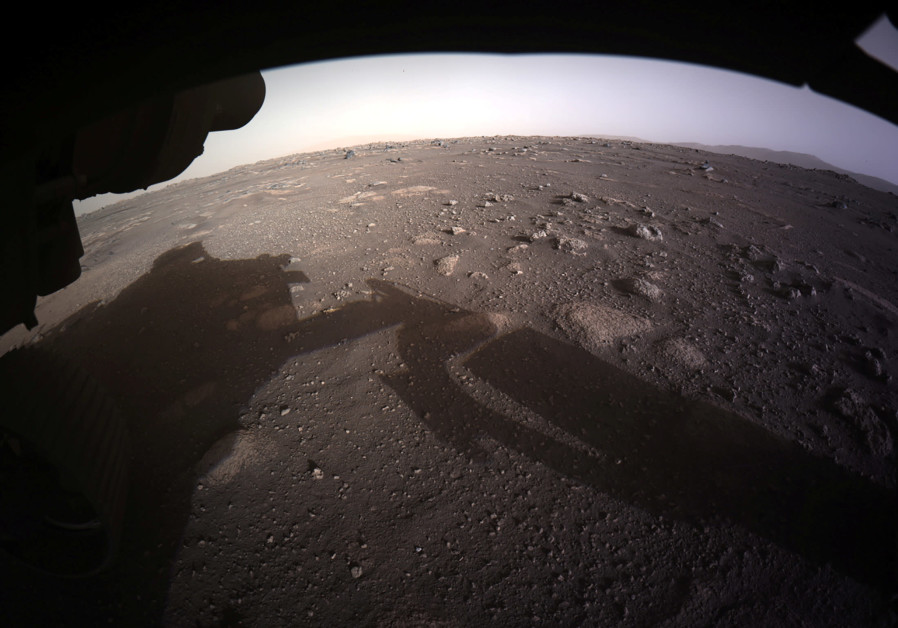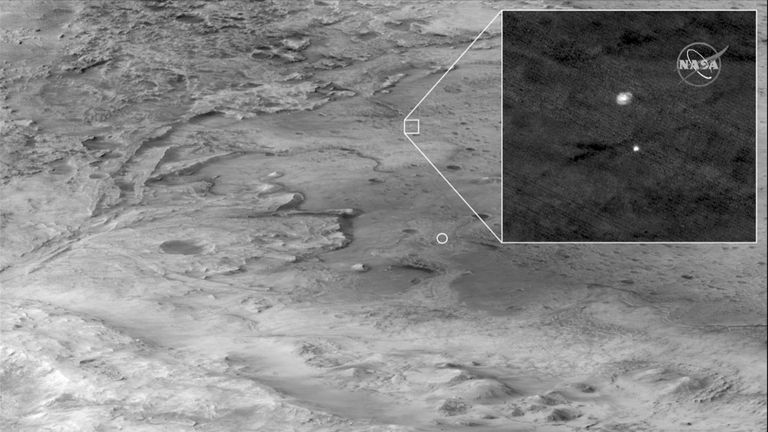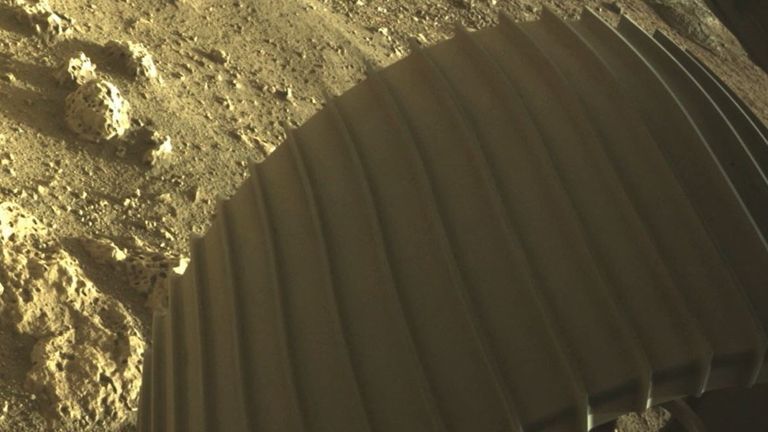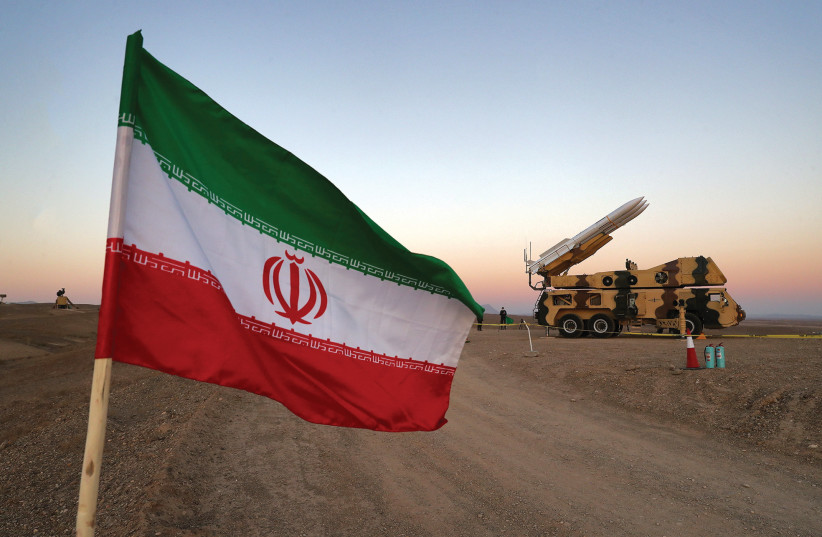'Something we've never seen' - Mars rover beams back selfie
The image was taken at the very end of the so-called "seven-minutes-of-terror" descent sequence.












Oorgrens veiligheid
A farm attack took place on the night of 17 February 2021, on a smallholding in the Roodeplaat area just outside Pretoria, in the Gauteng province of South Africa. A family was attacked and assaulted in their home by an unknown number of armed attackers. A female victim (48) was stabbed in her face during the attack.
The Kameeldrift police and other role players responded and the woman was transported to hospital for medical attention with serious wounds. The trauma unit was arranged to give counselling and to assist the family.
The police are investigating but there have been no arrests. There is no other information available at this stage.
Information supplied by Oorgrens veiligheid
https://southafricatoday.net/south-africa-news/gauteng/farm-attack-family-overpowered-in-their-home-woman-stabbed-in-the-face-roodeplaat/
Oorgrens veiligheid
A farm attack took place on the night of 18 February 2021, at 23:00, in the Louis Trichardt area of the Limpopo province in South Africa. Farm workers were assaulted and tied up by panga (machete) wielding attackers who then invaded the farmhouse and attacked an elderly couple.
The elderly couple were violently assaulted causing the woman’s dentures to break after being bashed in the face with a panga. The elderly man was also severely beaten by the attackers who then robbed them of a number of household items and fled in their vehicle.
There is a lookout for the couples vehicle, a maroon Kia Sorento SUV with registration DNS339L.
All roleplayers responded and medical attention was arranged for the couple. The police are investigating but there have been no arrests. There is no other information available at this stage.
Information supplied by Oorgrens veiligheid
https://southafricatoday.net/south-africa-news/limpopo/farm-attack-elderly-couple-severely-assaulted-by-panga-wielding-thugs-louis-trichardt/
Stephen Hawking made a bet in 1974, as a form of insurance against his life's work, that the object wasn't a black hole.
Sky News, Friday February 19, 2021

The first black hole that humanity ever discovered is much more massive than previously thought, according to new research.
The galactic X-ray source, later named Cygnus X-1, was discovered in 1965, when a pair of Geiger counters were carried on board a sub-orbital rocket launched from New Mexico.
It was the focus of a famous scientific bet between physicists Stephen Hawking and Kip Thorne in 1974, with Professor Hawking wagering that it wasn't a black hole.

Professor Hawking described the bet as "a form of insurance policy" in his book A Brief History of Time.
"I have done a lot of work on black holes, and it would all be wasted if it turned out that black holes do not exist," he wrote. "But in that case, I would have the consolation of winning my bet, which would win me four years of the magazine Private Eye.
"If black holes do exist, Kip will get one year of Penthouse," he added. In the end, Mr Hawking conceded the bet in 1990.
New observations published in the journal Science have now proven that he was right to do so.
The research has found that Cygnus X-1 contains the most massive stellar-mass black hole ever detected without the use of gravitational waves.
An international team of astronomers used the Very Long Baseline Array, a continent-sized radio telescope made up of 10 dishes spread across the US, together with a clever technique to measure distances in space to establish the black hole's size.
"If we can view the same object from different locations, we can calculate its distance away from us by measuring how far the object appears to move relative to the background," said lead researcher, Professor James Miller-Jones.
"If you hold your finger out in front of your eyes and view it with one eye at a time, you'll notice your finger appears to jump from one spot to another. It's exactly the same principle," added Prof Miller-Jones, from Curtin University and the International Centre for Radio Astronomy Research (ICRAR).
"Over six days we observed a full orbit of the black hole and used observations taken of the same system with the same telescope array in 2011," the professor said.
"This method and our new measurements show the system is further away than previously thought, with a black hole that's significantly more massive."

Co-author Professor Ilya Mandel from Monash University said the black hole is actually so massive it is challenging a lot of astronomers' ideas about how black holes form.
"Stars lose mass to their surrounding environment through stellar winds that blow away from their surface. But to make a black hole this heavy, we need to dial down the amount of mass that bright stars lose during their lifetimes," he said.
"The black hole in the Cygnus X-1 system began life as a star approximately 60 times the mass of the Sun and collapsed tens of thousands of years ago," he said. "Incredibly, it's orbiting its companion star - a supergiant - every five and a half days at just one-fifth of the distance between the Earth and the Sun.
"These new observations tell us the black hole is more than 20 times the mass of our Sun, a 50% percent increase on previous estimates," Prof Mandel added.
Applications for aspiring astro- and para-nauts will open on March 31 for a period of eight weeks, after which the six-stage selection process will begin.
“We did not evolve to go to space so when it comes to space travel, we are all disabled,” said Captain Samantha Cristoforetti, an Italian European Space Agency astronaut.
Candidates are required to have knowledge of or a degree in at least one of the following: physics, biology, chemistry, mathematics, engineering or medicine.
The agency is also opening applications to the physically disabled who meet the expertise requirements, including those who have single or double foot or leg deficiency, and persons of short stature (<130 cm). The move was widely feted and championed across Twitter this week.
However progressive the move may have been for many, some are never happy it seems, with the extremely woke brigade seizing the opportunity to point out the shortcomings of the initiative, namely, that only the physically and not the mentally disabled could apply.
Others took the opportunity to highlight structural discrimination in the education system which precludes many already disadvantaged children from ever realizing their dreams of becoming astronauts.
https://www.rt.com/news/515948-esa-recruitment-disabled-astronauts/
Oorgrens veiligheid
A farm attack took place on the morning of 18 February 2021, in Muldersdrift, Krugersdorp, in the Gauteng province of South Africa. An elderly couple were overpowered in their home on a smallholding and very badly assaulted by an unknown number of attackers.
The attackers fled in the couple’s vehicle, a 1994 Hyundai Elantra with Reg KGF989GP. The vehicle has some hail damage.
There is no other information available at this stage.
Information supplied by Oorgrens veiligheid
South Africa Today – South Africa News
https://southafricatoday.net/south-africa-news/gauteng/farm-attack-elderly-couple-severely-assaulted-robbed-vehicle-lookout-muldersdrift/


The principal of a public school in New York City has sent out literature that asked parents to “reflect” on their “whiteness” with a ranked list of “White Identities,” the New York Post confirmed Tuesday.
Parents whose children attend the East Side Community School reportedly viewed a ranked list of “The 8 White Identities,” ranging from “White Supremacist” to “White Abolitionist.”
Authored by Barnor Hesse, an associate professor of African American Studies at Northwestern University, the ranked list is introduced with the following statement:
There is a regime of whiteness, and there are action-oriented white identities. People who identify with whiteness are one of these. It’s about time we build an ethnography of whiteness, since white people have been the ones writing about and governing Others.
Hesse’s eight identities are:
The “white supremacist” identity is found in the “red zone” of a color-coordinated meter that accompanied the handout, and is described as “clearly marked white society that preserves, names, and values white superiority,” while a “white abolitionist,” in the green zone, is one who is “changing institutions, dismantling whiteness, and not allowing whiteness to reassert itself.”
According to the Post, a New York City Department of Education official said some parents at the 6th-12th grade school first shared the handout with school staff. Subsequently, the principal, Mark Federman, distributed the material to every parent “as part of a series of materials meant for reflection” and as ‘food for thought,” the report said.
In a statement to the Post, a Department of Education spokesperson said:
Anti-racism and the celebration of diversity is at the core of our work on behalf of the young people of New York City, and the East Side Community School’s students, parents and staff partner together to advance equity in their community.
The document in question was shared with the school by parents as a part of ongoing anti-racist work in the school community and is one of many resources the schools utilizes.
The spokesperson reportedly added school employees are experiencing threats over the materials.
“Our staff are now being targeted with vile racist, anti-Semitic and homophobic slurs and degrading language from people outside of their school and nothing justifies the abuse directed at our educators,” the department representative reportedly said.
In 2007, Federman was arrested after he attempted to block security guards to stop them from embarrassing a 17-year-old student who had been charged with punching a guard in the eye and was about to be removed from the school in handcuffs.
Federman reportedly demanded the guards remove the girl from the school through a secluded back door in order to prevent her from being seen by other students.
Critical Race Theory investigator Christopher Rufo of the Discovery Institute tweeted the color-coded meter of “white identities” that shows the curriculum is sponsored by the Slow Factory Foundation, a nonprofit that seeks to build “anti-racist community and growing climate-positive global movements,” according to its website.
The foundation’s open education institute states it provides “equity-centered education for Black, Brown, Indigenous and minority ethnic communities, taught by Black, Brown, Indigenous and minority ethnic scholars, thinkers and educators.”
The organization defines “equity-centered education” (ECE) as:
Education that acknowledges power structures and historical social context as a key driver of any topic. Focusing on free and open accessibility, ECE initiatives are typically offered without academic admission requirements and distributed online. Open education broadens access to learning and training traditionally offered through formal education systems or corporate programs that are inaccessible to most people.
Among its offerings for its “equity-based education” are courses with these titles:
The “special advisor” to the foundation is designer and actor Waris Ahluwalia.
https://www.breitbart.com/politics/2021/02/17/new-york-city-school-asks-parents-to-rank-their-whiteness/